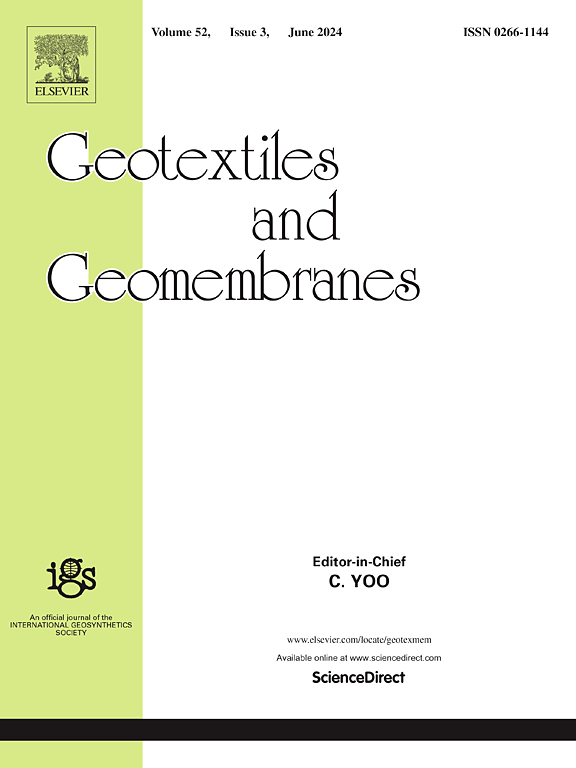Influence of column spacing on geosynthetic-encased columns behavior in very soft clay
IF 6.2
1区 工程技术
Q1 ENGINEERING, GEOLOGICAL
引用次数: 0
Abstract
This study evaluates the influence of column spacing on the mechanical behavior of geosynthetic-encased columns (GECs) installed in very soft clay under vertical surcharge loading. A large-scale physical model (1.6 m × 1.6 m × 1.2 m) was instrumented with settlement gauges, piezometers, and pressure cells to monitor performance. Column spacing varied between 2.0D and 3.5D (D = column diameter) to assess effects on settlement, excess pore pressure, stress distribution, and the lateral earth pressure coefficient (K). Smaller spacings led to reduced settlements, faster pore pressure dissipation, and more efficient stress transfer to the columns. In contrast, larger spacings resulted in higher excess pore pressures and reduced system effectiveness. The coefficient K varied with spacing and depth: higher K values were associated with smaller spacings and shallower depths due to increased lateral confinement and interaction among columns. Conversely, deeper measurements showed lower K values due to limited lateral deformation. Comparison between measured and predicted settlements and encasement forces demonstrated good agreement, validating existing analytical models. The findings highlight the critical role of column spacing in optimizing the performance of GEC-reinforced soft soils under surcharge loading.
极软黏土中柱间距对土工合成包壳柱性能的影响
本文研究了竖向附加荷载作用下,柱间距对极软黏土中土工合成包覆柱力学性能的影响。在大尺度物理模型(1.6 m × 1.6 m × 1.2 m)上安装沉降计、压力计和压力传感器来监测性能。柱间距在2.0D ~ 3.5D (D =柱径)范围内变化,评价其对沉降、超孔隙压力、应力分布和侧土压力系数(K)的影响。较小的间距减少了沉降,更快的孔隙压力消散,更有效地将应力传递到柱上。相反,更大的间距会导致更高的超孔隙压力,降低系统效率。系数K随间距和深度的变化而变化:由于柱间的侧向约束和相互作用增加,较高的K值与较小的间距和较浅的深度相关。相反,由于有限的侧向变形,较深的测量显示较低的K值。实测和预测的沉降和包围力之间的比较显示出良好的一致性,验证了现有的分析模型。研究结果强调了柱间距对优化加筋软土在附加荷载作用下的性能的关键作用。
本文章由计算机程序翻译,如有差异,请以英文原文为准。
求助全文
约1分钟内获得全文
求助全文
来源期刊

Geotextiles and Geomembranes
地学-地球科学综合
CiteScore
9.50
自引率
21.20%
发文量
111
审稿时长
59 days
期刊介绍:
The range of products and their applications has expanded rapidly over the last decade with geotextiles and geomembranes being specified world wide. This rapid growth is paralleled by a virtual explosion of technology. Current reference books and even manufacturers' sponsored publications tend to date very quickly and the need for a vehicle to bring together and discuss the growing body of technology now available has become evident.
Geotextiles and Geomembranes fills this need and provides a forum for the dissemination of information amongst research workers, designers, users and manufacturers. By providing a growing fund of information the journal increases general awareness, prompts further research and assists in the establishment of international codes and regulations.
 求助内容:
求助内容: 应助结果提醒方式:
应助结果提醒方式:


